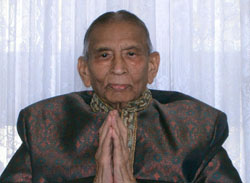
NAMASTE
The word Namaste in Sanskrit means “I bow to the divine in you”. The gesture that accompanies the word, involves holding both hands in front of the chest or face, with or without also bowing the head and the upper part of the body (see the accompanying picture on the home page). Indians use this gesture to greet someone (like “Hi” in western cultures) or at the end of a meeting to say good-bye. In either case the use of this gesture is a very special way of acknowledging someone. The special nature of Namaste is that it at once conveys respect as well as acknowledgment of the other party.
In my opinion, of all the many ways the various peoples of the world greet one another, this is the most elegant, the most respectful and along with the simple bowing of the Japanese, the most hygienic. Contrast that with hugging, shaking hands, rubbing noses, touching cheek with cheek or (the worst of all practices) kissing on the lips. Not only do all of these forms have hygiene implications of varying degrees but none of them implies respect for the party being greeted. In the post-Covid-19 pandemic world, this particular aspect of greeting one another is especially pertinent, .from the view point of epidemiology. Of note is the recent recommendation of asking the public to cough and/or sneeze into their folded elbow(s), while at the same time, the Covid-19 pandemic-prompted style of greeting is, ironically, touching one another with the folded elbows!! This is the most ludicrous recommendation, if it came from epidemiologists!
When the same joined hands are held above the head, Hindus use this gesture exclusively for praying. This is common practice in temples or while worshipping the sun (for example, at the bank of, or in the river Ganga). This is also used in some asanas that are integral parts of Hatha Yoga.
As the practice of Namaste is as old as Hinduism, when other religions use it in prayer, one has to conclude that they ‘borrowed’ this from Indians. And like many aspects of their life, when people from Thailand use Namaste as a part of greeting, they owe India and Indians some gratitude. This gesture was brought to them tby the Hindu rulers initially but through practitioners of Buddhism.

ADDENDUM: I don't know if others have noticed this, but to my amusement, I have. The topic I am mentioning is the way now almost all people in the US (and other Western countries), when they come in or leave a stage, the way they greet is this Namaste! Hi! seems to have taken backstage. I wonder how many of those stars and other luminaries know the meaning of this quintessential Indian gesture!